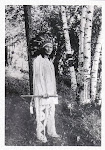It is very fitting that Camp Fire USA and Boy Scouts of America are honoring Ohiyesa/Dr. Charles Eastman in 2010 as they celebrate their 100th anniversaries.
Eastman, who was raised traditionally until the age of 14, retained his language, both reading and writing in it, till death. At the time he attended American schools, Indians were known only negatively as savages. Eastman, through his famous classic American work "Indian Boyhood" about his early life, helped Americans change their view of what a "savage" education was. Prior to Eastman, it was either viewed as brutal and warlike or romantically "noble." Eastman showed that his childhood was both free in the outdoors and incredibly disciplined and systematic in his community teachings of values, respect, natural history, tribal history, mental acuity and ingenuity, survival skills, outdoors games, and spirituality. His book subverted the negativity of the word "savage" and suddenly educators were looking to him and to Indian life for strengths that American culture was losing in their youth because of required daily indoor schooling and the disrespectful "sassiness" of young people.
At that time, the Pan-Indian movement was growing among Indians nations as they met each other in the forced boarding schools and they realized that in terms of values and upbringing, they had more in common with each other than with the whites that were part of the mainstream American culture that was in a sweep of ethnic cleansing, stealing their lands, penning them on reservations, and militarily and legally making them "assimilate." Also, if they wanted to have any political power, they had to unite, and it was their commonalities that united them in contrast to mainstream America that did not recognized them as legitimate.
Eastman's Pan-Indian values, rituals and lore were born of this time period and these aspirations for understanding and recognition. He did not want individual tribes to lose their identities -- he fought valiantly in the courts and in the press for their rights -- but instead he wanted to impress upon whites the significant common values and skills that Indians shared that were counter culture. By educating American youth in amalgamated Pan-Indian elements, Eastman and many other Indians of the time believed that American youth would have greater respect for the Indians in their nation and Indians could hold their heads up with pride in any society.
Eastman was right about this. He and his colleagues produced major shifts in American thinking through these educational efforts. One cannot understand this unless one lived prior to Eastman and afterward, but the contributions of Ohiyesa/Eastman and his colleagues in the Society of American Indians (SAI) are immense and still felt today. Unfortunately, it is true that familiarity can breed contempt, and some individuals and groups have intentionally or unintentionally substituted the surface information Eastman provided as an overview of commonalities for the reality, diminishing and dismissing individual Indian nations and cultures.
The history of Camp Fire shows that it respectfully tried hard to distinguish their work-health-love (WOHELO) rituals based on Pan-American guides offered to them by Eastman from those of Indian nations. The organization urged youth to learn about the Indian nations near them.
The challenge now for the Boy Scouts of America and the Camp Fire Organization is to acknowledge these roots and Eastman's gift to them and again send out all their members to learn more about the individual Indian nations living locally in their midst and as part of their membership. As in Camp Fire, the members need also to investigate their own ethnic backgrounds to discover values, rituals, and ethnic clothing of their ancestors. We do not have to disregard the past but instead enliven it with greater knowledge now.
So I agree that it is inadequate and can be disrepectful to pass on the Pan-Indian materials without explaining their origins and intents and explaining the difference between such elements and the real cultural rituals and items. We need to offer more depth, not less. And we must acknowledge the value in sharing of ethnic customs and what Native Americans have contributed to our nation and youth organizations in particular and in conglomerate ways. What Eastman shared has helped open minds and discussions for over a century -- and and have gotten American youth engaged with the woods and plains and in service in positive ways. Eastman would be very supportive of the present No Child Left Inside movement and those working to prevent the Nature Deficit Disorder, as noted in Richard Louv's book "Last Child in the Woods." All his life, he was a great supporter of the Boy Scouts and Camp Fire Girls, and he strove to get Indian nations to create their own versions of such youth organizations to pass on their specific traditions that were being lost. He felt that under the cover of such organizations, the Indian nations could preserve parts of their cultures against the genocidal laws at work in the United States that forbid Indian nations to speak their languages, educate their own children, or hold religious observance or retain sacred items. Until the 1930s, their traditions and language were outlawed.
(P.S. Unfortunately, Eastman was erroneously portrayed as a complete assimilationist in the documentary "Bury My Heart at Wounded Knee.")
Marybeth Lorbiecki
Eastman biographer
"Beyond Wounded Knee: The Life and Works of OHIYESA: Charles Alexander Eastman" to be released
Wednesday, January 13, 2010
Subscribe to:
Post Comments (Atom)





No comments:
Post a Comment